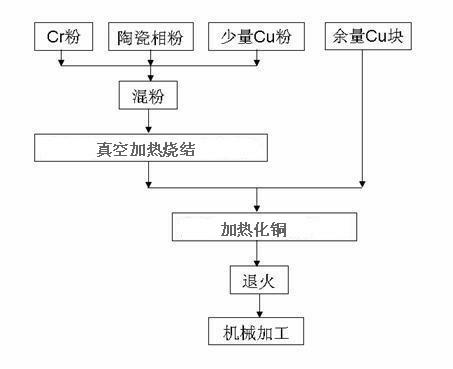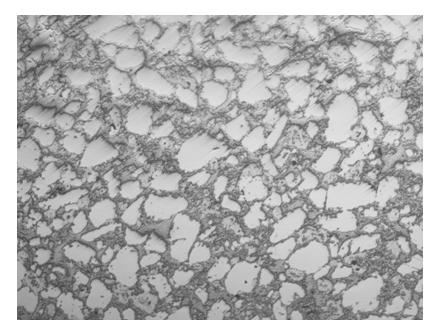Vacuum copper-based electrical contact composite material containing ceramic phase and preparation method of vacuum copper-based electrical contact composite material
A composite material and ceramic phase technology, applied in the field of powder metallurgy, can solve problems such as poor high-temperature electrical conductivity, no Cr phase, mechanical strength and welding resistance that cannot meet the requirements of medium and high voltage vacuum switches, and achieve high withstand voltage capacity and breaking capacity, the effect of high mechanical strength
- Summary
- Abstract
- Description
- Claims
- Application Information
AI Technical Summary
Problems solved by technology
Method used
Image
Examples
Embodiment 1
[0025] Composition ratio: Cu 5.00 kg, accounting for 50% by mass;
[0026] Cr 4.71 kg, accounting for 47.1% by mass;
[0027] B 4 C 0.29kg, accounting for 2.9% by mass.
[0028] (1) According to the above chemical ratio, weigh 4.71kg of chromium powder and 0.29kg of boron carbide powder and mix evenly, then mix in 0.5kg of copper powder, and mix the powder with a powder mixer for 8 hours;
[0029] (2) Put the mixed powder into the crucible and press it flat, place the crucible in a vacuum heating furnace, and evacuate to ≤5x10 -2 After Pa, heat to 1000°C and keep it warm for 10 hours to obtain the sintered composite powder, and turn on the furnace to cool;
[0030] (3) Put 4.5kg copper rod in the crucible, start the vacuum heating furnace again, rapidly raise the temperature to 1350°C, and start copperization. After the copperization is completed, lower the temperature to 1100°C, keep it for 60 minutes, and finally turn off the heating system to obtain a...
Embodiment 2
[0041] Composition ratio: Cu 5.17kg, accounting for 51.65% by mass;
[0042] Cr 4.57kg, accounting for 45.7% by mass;
[0043] B 4 C 0.265kg, accounting for 2.65% by mass.
[0044] (1) According to the above chemical ratio, weigh 4.57kg of chromium powder and 0.265kg of boron carbide powder and mix evenly, then mix in 0.457kg of copper powder, and mix the powder with a powder mixer for 8 hours;
[0045] (2) Put the mixed powder into the crucible and press it flat, place the crucible in a vacuum heating furnace, and evacuate to ≤5x10 -2 After Pa, heat to 1400°C and keep it warm for 0.5 hours to obtain the sintered composite powder, then turn on the furnace to cool;
[0046] (3) Put 4.713kg of copper rod in the crucible, start the vacuum heating furnace again, rapidly raise the temperature to 1350°C, and start copperization. After the copperization is completed, lower the temperature to 1200°C, keep it for 20 minutes, and finally turn off the heating system ...
Embodiment 3
[0054] Composition ratio: Cu 6.78 kg, accounting for 67.8% by mass;
[0055] Cr 3.00 kg, accounting for 30% by mass;
[0056] B 4 C 0.22kg, accounting for 2.2% by mass.
[0057] (1) According to the above chemical ratio, weigh 3.00kg of chromium powder and 0.22kg of boron carbide powder and mix evenly, then mix in 0.45kg of copper powder, and mix the powder with a powder mixer for 8 hours;
[0058] (2) Put the mixed powder into the crucible and press it flat, place the crucible in a vacuum heating furnace, and evacuate to ≤5x10 -2 After Pa, heat to 1000°C and keep it warm for 5 hours to obtain the sintered composite powder, and turn on the furnace to cool;
[0059] (3) Put 6.33kg copper rod in the crucible, start the vacuum heating furnace again, rapidly raise the temperature to 1350°C, and start copperization. After the copperization is completed, lower the temperature to 1150°C, keep it for 30 minutes, and finally turn off the heating system to obtain ...
PUM
| Property | Measurement | Unit |
|---|---|---|
| density | aaaaa | aaaaa |
| hardness | aaaaa | aaaaa |
| density | aaaaa | aaaaa |
Abstract
Description
Claims
Application Information
 Login to View More
Login to View More - R&D
- Intellectual Property
- Life Sciences
- Materials
- Tech Scout
- Unparalleled Data Quality
- Higher Quality Content
- 60% Fewer Hallucinations
Browse by: Latest US Patents, China's latest patents, Technical Efficacy Thesaurus, Application Domain, Technology Topic, Popular Technical Reports.
© 2025 PatSnap. All rights reserved.Legal|Privacy policy|Modern Slavery Act Transparency Statement|Sitemap|About US| Contact US: help@patsnap.com



